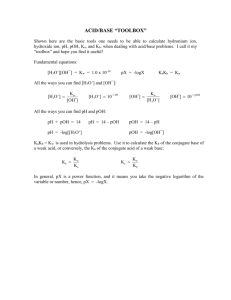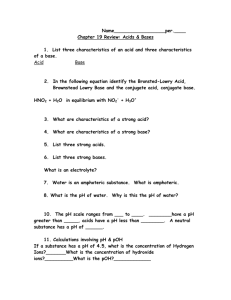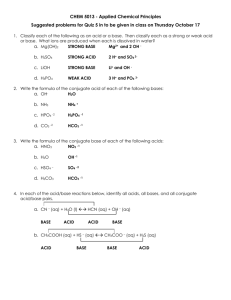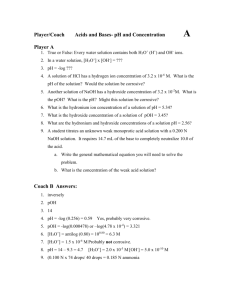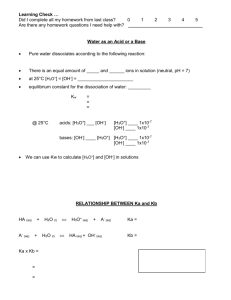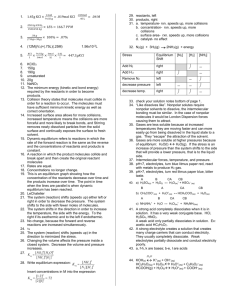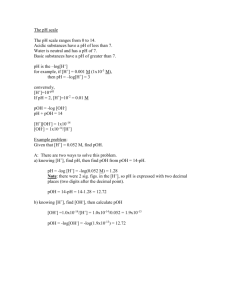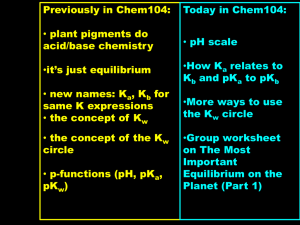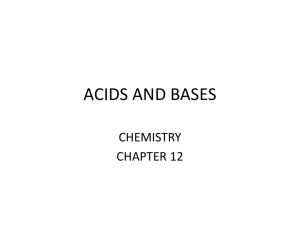Lecture 17 Highlights…
advertisement
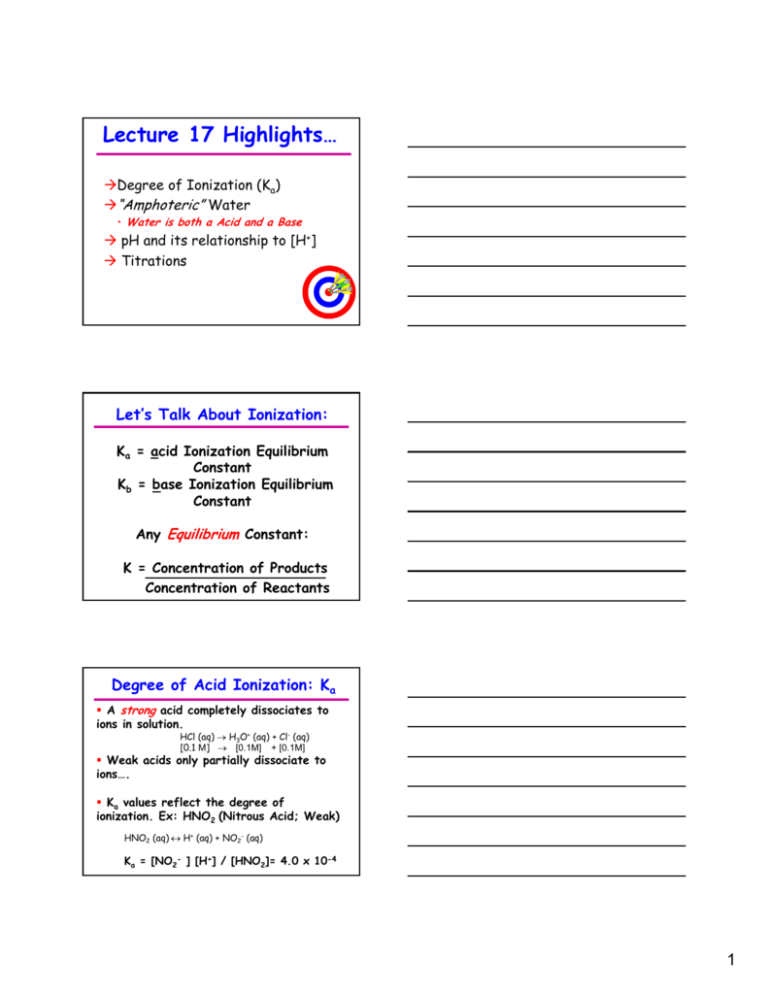
Lecture 17 Highlights…
ÆDegree of Ionization (Ka)
Æ“Amphoteric” Water
• Water is both a Acid and a Base
Æ pH and its relationship to [H+]
Æ Titrations
Let’s Talk About Ionization:
Ka = acid Ionization Equilibrium
Constant
Kb = base Ionization Equilibrium
Constant
Any Equilibrium Constant:
K = Concentration of Products
Concentration of Reactants
Degree of Acid Ionization: Ka
A strong acid completely dissociates to
ions in solution.
HCl (aq) → H3O+ (aq) + Cl- (aq)
[0.1 M] → [0.1M] + [0.1M]
Weak acids only partially dissociate to
ions….
Ka values reflect the degree of
ionization. Ex: HNO2 (Nitrous Acid; Weak)
HNO2 (aq) ↔ H+ (aq) + NO2- (aq)
Ka = [NO2- ] [H+] / [HNO2]= 4.0 x 10-4
1
More on Ka For Weak Acids
and Bases
Ka values are so-called “equilibrium
constants” since they represent the ratio
of products (ions formed) to reactants
(acid or base) in a “reaction” (dissociation).
Ka values reflect the degree of
ionization. Generally: HA (aq) → H+ (aq) + A- (aq)
Ka = [Ion Product A ] [Ion product H+] /
[Reactant]
Ka = [A- ] [H+] / [HA]
Sample Exercise 16.1: Calculate the value of [H+] of
0.100 M Acetic Acid. (Ka = 1.76x10-5).
C2H3OOH (aq) Æ C2H3OO- (aq) + H+ (aq)
ICE Table
[C2H3OOH]
[C2H3OO-]
[H+]
Initial
0.1M
-
-
Change
-X
+X
+X
Equilibrium
0.1M - X
X
X
2
What if X is not small
compared to the
[Original Acid or Base] ?
/
Let’s look at the Nitrous Acid example
ICE Table
[HNO2]
[NO2]
[H+]
Initial
0.1M
-
-
Change
-X
+X
+X
Equilibrium
0.1M - X
X
X
(X)(X)
(0.100 – X)
= 4.0x10-4
3
Doing the Math….
Degree of Ionization
Definition: The ratio of the quantity of a
substance that is ionized to the total quantity of
the substance that is present .
For the nitrous acid case:
[H+] = 6.1 x 10-3 M after ionization
[Original Concentration of unionized] HNO2 = 0.1M
So, 6.1 x 10-3 M / 0.1M = 0.061 = 6.1%
Water: An Acid and a Base
Water can both accept and donate a
proton… It’s “amphoteric”.
H20 (l) + H20 (l) ↔ OH- + H3O+ (Auto-ionization)
Acid + Base ↔ Conjugate Base + Conjugate Acid
At auto-ionization “equilibrium”:
Kw = [H3O+ ] [OH-] = 1 x 10-14
Where: [H3O+ ] = [OH-] = 1 x 10-7 (Very Low Conc. !)
So, in a solution where [H3O+ ] > [OH-], it’s acidic
And, in a solution where [H3O+ ] < [OH-], it’s basic
4
Amphoteric Nature of Water
Dynamic Computer Model of Water Structure
Clusters of
Water Molecules
16_05.jpg
What is pH ?
Very simply……the “potential” of the
hydrogen ion” (SØren SØrenson, 1868-1939).
pH = - log [H3O+ ] in water
or, generally, pH = - log [H+]
So, at “equilibrium”:
[H3O+ ] = [OH-] = 1 x 10-7
Then the pH of “neutral” water is: 7 !
5
Calculating the pH of a Solution
• What is the pH of a sample of melted
snow for which [H+] (actually [H3O+])
is 4.61 x 10-4 ?
• pH = -log [H+] = -log [4.61 x 10-4 ]
• pH = 3.34
Error in notes
Calculating the [H3O+] of a
Solution of Known pH
• If an aqueous solution has a pH of
3.34, what is the concentration of
H3 O + ?
• pH = -log [H3O+ ] = 3.34
Or, log [H3O+ ] = -3.34
• [H3O+ ] = antilog (-3.34) = 10-3.34
[H3O+ ] = 4.6 x 10-4
pH Scale
Acidic from dissolved CO2
Acid Rain…….
6
pOH
Numerous expressions of solution composition
and chemistry start with a lowercase “p”
symbolizing the –log (x) math function.
In addition to pH, we have:
pOH = -log [OH-]
-log Kw = -log {[H+][OH-]} = -log (1.00 x 10-14)
pKw = pH + pOH = 14.00
pOH Exercise
Sample Exercise 16.7:
Calculate the pOH and pH of 0.0100 M NaOH in
aqueous solution.
NaOH (aq) Æ Na+ (aq) + OH- (aq)
pOH = -log [OH-] = -log (0.0100) = 2.00
pOH + pH = pKw = 14.00
pH = 14.00 – pOH = 14.00 – 2.00 = 12.00
7
